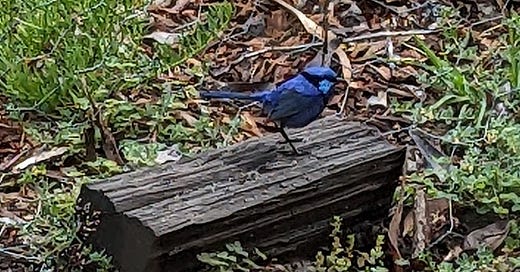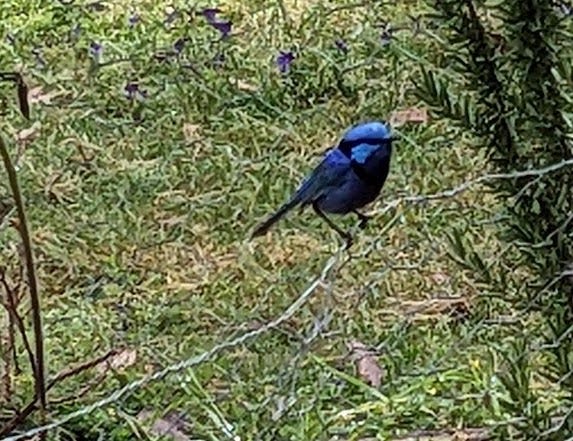There is a blue wren outside my office window as I type. More accurately, a Splendid Fairy Wren. A male. Chirping and dancing across the ground between the house and the creek. A splash of cobalt blue against the green. Fading now as summer wears on and his breeding plumage dulls.
It’s a yearly cycle, the blueing of the wrens. In winter, the males and females are practically indistinguishable - both dull brown. There is a slight difference in the colour of their tail feathers; the female’s is turquoise, the male’s cobalt. Come late winter and early spring, the males shed their cryptic brown garb and turn blue. Bright blue. Irridescent.
It’s about sex, of course. Female wrens find bright blue males attractive. Males that turn bright blue get to mate more often and pass on their tendency to turn bright blue to more offspring. So the two things reinforce each other, the changing colour and the finding it attractive.
I did a bit of digging around about how and why blue wrens turn blue a while ago for a segment I was doing for the local radio station. In the process, I came across a paper from 1837, when the writer (John Bachman, D.D., President of the Literary and Philosophical Society of Charleston, USA) was musing about how and why birds’ feathers change colour. Interesting to reflect that was before Darwin had released The Origin of Species, so ideas of evolutionary selection were not on the radar. At that time it was unknown as to whether the feathers themselves changed colour or if the birds moulted and grew feathers of the new colour. And Bachmann could only speculate as to why such a thing occurred.
We know today that evolutionary pressure has created dance between brightly coloured males and females that think they’re sexy. Not so sexy though as to inspire fidelity. Ornithologists describe fairy wrens as ‘socially monogomous but sexually promiscuous’, which warrants explanation. It works like this: fairy wrens form pair bonds and that pair produces eggs and hatches young. But as anyone who has had anything to do with raising babies of any sort knows, doing so takes considerable work. So the fairy wren pair enlists some helpers - auxilliaries the scientists call them. They’re mostly offspring from previous years and they help defend territory, find food, care for the chicks. That sort of thing. Meanwhile, the breeding pair often sneak off for a little ‘interaction’ with fine-feathered friends from neighbouring groups. Quite a lot of interaction, as it turns out. One study found that extrapair matings occured in over half of nests. In fact about 40 per cent of chicks basically failed their paternity tests - Daddy turned out to be that nice bright male wren from the neighbouring shrubbery, not the one in this ‘socially monogomous’ pair.
It’s a complex world when you’re a fairy wren.
Ornithologists suggest that alliances (I’m tempted to put that in inverted commas too) between neighbouring breeding groups likely help birds to better defend against predators and lessen aggression between groups. Uh huh. Sure. Jokes aside, fairy wrens do have complex social structures and have been shown to more quickly come to the help of birds from within their social group than to those from other groups. It does make sense that links between neighbouring groups could work in everyone’s favour.
So, males change colour during breeding season to increase their chances of getting the girl. We also now know how the colour change occurs. The dull feathers are moulted and the bright feathers are newly grown.
Birds have two different ways of colouring feathers – structural means, whereby the actual structure of the feathers reflects certain wavelengths of light, and pigmentation, where the production of colour pigments causes the colour. In the case of the blue wrens, it’s the structural type of colouration. Which is why they get that metallic sheen as they flit about in the sun. One of the downsides of this sort of plumage colouration is that it is particularly susceptible to fading as feathers become damaged. It would seems fair to think that would mean brightly coloured male wrens would spend a lot of time preening, but this is not the case. According to research done by Alexandra McQueen at Monash University, males keep their colours in pristine condition by re-moulting parts of their breeding plumage throughout the breeding season. Basically, when the feathers get damaged or dull, the birds replace them with new, bright feathers, rather than tart up the existing feathers.
McQueen was looking at a different but related species (Superb Fairy Wren Malurus cyaneus) to the ones I see flitting around home (Splendid Fairy Wren Malurus splendens), but her research is relevant to my understanding of the local birds. McQueen found that females preferred males that changed colour early in the season and remained blue for longer. She also found that males seemed aware of their increased risk of being preyed upon when they were carrying their bright blue feathers - they respond faster and more often to alarm calls and spend more time being vigilant while they are blue. It’s not only female splendid wrens that notice the bright blue males. Predators do too. That’s why the males flit about so much - there one minute, gone the next. It’s why the females spend more time out in the open. It’s surprising how readily the males can hide, given how brightly coloured they are.
The bright plumage comes at a cost - it takes energy to replace dull feathers and it’s hard work staying alive when you stand out from the crowd. So it makes sense that the bright colours are only maintained during breeding season. The rest of the year, they moult back to the more cryptic brown colour, and go about life in a far more relaxed manner.
See you outside,
Jill





They are so splendid aren't they. I was interested to hear that they actually grow new colored feathers and how promiscuous this little buggars are. Enjoying your writing.